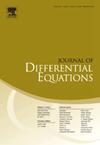快慢化学反应:Hamilton-Jacobi方程的收敛性和变分表示
IF 2.3
2区 数学
Q1 MATHEMATICS
引用次数: 0
摘要
化学反应的微观行为可以用随机时变泊松过程来描述,泊松过程的大体积极限决定了物质浓度的宏观行为,包括典型和非典型轨迹。当反应强度(或通量)呈现快慢尺度分离时,宏观典型轨迹由ε依赖的非线性反应速率方程(RRE)控制,而偏离典型轨迹的非典型轨迹则由ε依赖的指数非线性Hamilton-Jacobi方程(HJE)表征。对于一般化学反应,在状态约束边界条件下,研究了相关HJE黏度解的快慢极限为ε→0。我们确定了慢流形上的极限有效HJE,以及解的有效变分表示。通过粘度解的一致收敛性和变分解表示的Γ-convergence,我们严格地证明了所有非典型(和典型)轨迹都集中在慢流形上,并且有效的宏观动力学分别由粗粒度RRE和HJE描述。这种研究快慢极限的方法适用于但不限于梯度流动描述的可逆化学反应。本文章由计算机程序翻译,如有差异,请以英文原文为准。
Fast-slow chemical reactions: Convergence of Hamilton-Jacobi equation and variational representation
Microscopic behaviors of chemical reactions can be described by a random time-changed Poisson process, whose large-volume limit determines the macroscopic behaviors of species concentrations, including both typical and non-typical trajectories. When the reaction intensities (or fluxes) exhibit a separation of fast-slow scales, the macroscopic typical trajectory is governed by a system of ε-dependent nonlinear reaction rate equations (RRE), while the non-typical trajectories deviating from the typical ones are characterized by an ε-dependent exponentially nonlinear Hamilton-Jacobi equation (HJE). In this paper, for general chemical reactions, we study the fast-slow limit as for the viscosity solutions of the associated HJE with a state-constrained boundary condition. We identify the limiting effective HJE on a slow manifold, along with an effective variational representation for the solution. Through the uniform convergence of the viscosity solutions and the Γ-convergence of the variational solution representations, we rigorously show that all non-typical (and also typical) trajectories are concentrated on the slow manifold and the effective macroscopic dynamics are described by the coarse-grained RRE and HJE, respectively. This approach for studying the fast-slow limit is applicable to, but not limited to, reversible chemical reactions described by gradient flows.
求助全文
通过发布文献求助,成功后即可免费获取论文全文。
去求助
来源期刊
CiteScore
4.40
自引率
8.30%
发文量
543
审稿时长
9 months
期刊介绍:
The Journal of Differential Equations is concerned with the theory and the application of differential equations. The articles published are addressed not only to mathematicians but also to those engineers, physicists, and other scientists for whom differential equations are valuable research tools.
Research Areas Include:
• Mathematical control theory
• Ordinary differential equations
• Partial differential equations
• Stochastic differential equations
• Topological dynamics
• Related topics

 求助内容:
求助内容: 应助结果提醒方式:
应助结果提醒方式:


